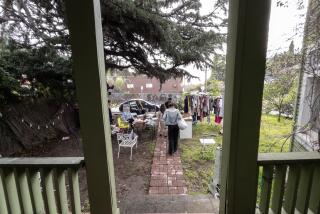Boxy Lizzie Home, Mansion Still Stand
- Share via
FALL RIVER, Mass. — Both of Lizzie Borden’s homes still stand in this mill town by the sea, but the neighborhoods around them little resemble the Fall River of 1892.
The murder scene was the boxy, narrow home at 92 Second Street, where Andrew and Abby Borden lived with his two daughters, Lizzie and Emma, and a maid, Bridget Sullivan.
In 1892, Second Street was a plain, pleasant, middle-class residential neighborhood. Today, Second Street is part of downtown Fall River. The former Borden homestead is privately owned by a printing company next door. The owners don’t give tours.
Several small businesses and a modern brick apartment complex now fill the spaces once occupied by the Bordens’ next-door neighbors. Across the street are the Fall River bus station and the Pearl Garden Chinese restaurant.
Down the street is a high-rise parking garage and, just around the bend, a Victorian-style restaurant named, of course, “Lizzie’s.”
It’s a mile or so to 306 French Street, the 14-room home Lizzie and Emma bought with their inheritance after Lizzie was acquitted of murdering their father and stepmother. The house, a rambling Victorian, sits high on Heritage Hill, the snazziest neighborhood of its day and still filled with mansions built by wealthy textile mill owners.
Lizzie had the house’s name, “Maplecroft,” chiseled into the front steps, an ostentatious Victorian breach of etiquette that makes the home easier to spot from the street today.
Unlike Lizzie’s early neighborhood, French Street retains its turn-of-the-century architecture, although many houses have been split into apartments or small businesses.
Maplecroft is an exception to the trend. The home is owned by an insurance adjuster, who maintains his business on the first floor and lives upstairs.
Again, the owners turn down requests for tours.
Fall River, about 50 miles south of Boston, was founded in 1659 by Pilgrims who migrated from Plymouth, about 30 miles away. It derives its name from the Quequechan River-- quequechan is the Pocasset Indian word for “falling water”--which cuts through the city and spills into Mt. Hope Bay.
During the 19th Century, the waterway powered the mills that made Fall River the world’s textile capital.
The city was at the height of its prosperity during Lizzie Borden’s lifetime, when the mills attracted workers from all over the world, pushing the city’s population to 120,000 people. At one point, 30,000 men, women and children worked in 101 mills for as little as 25 cents a day.
The decline began before the Great Depression. In 1928, the year after Lizzie Borden died, an enormous fire devastated much of the mill district.
Later, most of the mills were shut down, and the city’s population gradually dwindled to its current 92,000.
For decades, Fall River residents tried to disown the ghosts of the city’s most famous family. “If you considered yourself in any way a good, decent, respectable person, you didn’t discuss it,” said Michael Martins, curator of the Fall River Historical Society.
But Fall River appears to have made peace with the Bordens, in much the same way that another famous Massachusetts city, Salem, has acknowledged--and begun to trade on--an embarrassing chapter in its history, the witchcraft trials of 1692.
More to Read
Sign up for Essential California
The most important California stories and recommendations in your inbox every morning.
You may occasionally receive promotional content from the Los Angeles Times.












